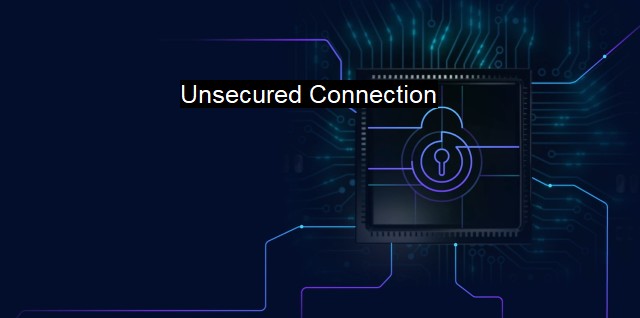What is Unsecured Connection?
Mitigating Cybersecurity Threats: Understanding Unsecured Connections and the Risks They Pose for Organizations
Understanding the cyber security landscape is imperative in our technologically driven society. Within this landscape, there are a wealth of concepts to understand, one of the most critical being the notion of an "unsecured connection.” This term predominantly circulates within the realm of networks, particularly the internet, and is a potential avenue for numerous cybersecurity threats and issues."Unsecured connection" can be defined as a connection to the internet or any network, which lacks certain protections like encryption or a firewall that safeguards it from unauthorized access or other types of cyber attacks. While encrypted data is turned into a code that can only be read with a unique key, making it much harder for cyber attackers to exploit, unencrypted data - typically sent over an unsecured connection - can be easily accessed and manipulated.
Public Wi-Fi networks at coffee shops, airports, hotels, or other such places are classic examples of unsecured connections. These are often established without password protection, allowing anyone within range to connect. They lack encryption, making all the data sent or received over the network such as emails, passwords or credit card details transparent and vulnerable. This makes it easy for potential attackers to intercept and collect this data.
The unsecured connection is a paradise for hackers for several reasons. The lack of stringent entry controls means hackers can easily infiltrate the network undetected. Once on the network, the lack of encryption allows these attackers to perform "sniffing" or "eavesdropping" attacks, essentially allowing them to observe and record all data transmitted over the network undetected.
Unsecured connections also present an opportunity for hackers to engage in more sophisticated forms of attacks. For instance, the man-in-the-middle attack – where a cyber-criminal positions themselves between the user and the application to intercept all data moving between the two. Similarly, it becomes feasible to execute a "Rogue Access Point," wherein an unauthorized device impersonates a legitimate network, directing all traffic through itself and cultivating a profound breach of privacy.
There are preventative measures that one can take to mitigate these threats, although none are completely foolproof. VPNs (Virtual Private Networks) provide an added layer of security by establishing a virtual encrypted "tunnel" between the user and the internet. All data passing through this tunnel is obscured, drastically decreasing the risks of eavesdropping.
Similarly, when using web applications, it is urgent to verify that connections are secured with HTTPS (indicated by a padlock icon in the address bar). HTTPS employs Transport Layer Security (TLS) to provide an additional encryption layer, ensuring the secure transit of data between your browser and the website.
Antivirus software also plays a pivotal role in securing connections. It alerts users when they attempt to access unsecured websites or download potentially harmful scripts. Through the provision of real-time security checks, the software can detect threats before they inflict any damage. Antivirus protection reduces the window of vulnerability, being absolutely essential in our increasingly interconnected world.
Despite these precautions, unsecured connections should generally be avoided whenever feasible. Genuine cybersecurity requires not only protective measures but also user-level awareness and adherence to safe online practices. The danger posed by an unsecured connection, particularly in relation to sensitive data transmission, cannot be naively overlooked in today’s cyber-threat landscape.
A comprehensive understanding of what an unsecured connection entails accompanied by the implementation of necessary safeguards, allows us to navigate our online world with an improved level of confidence and security. We have a responsibility to take proactive steps and protect our online foothold to ensure that our personal and professional lives remain secure against the seemingly ever-present cyber threats.

Unsecured Connection FAQs
What is an unsecured connection?
An unsecured connection is a network connection that lacks proper security measures to protect data being transmitted. This means that any data sent over the connection can be intercepted and accessed by unauthorized users.What are the dangers of using an unsecured connection?
Using an unsecured connection increases the risk of cyber attacks, such as hacking and malware infections. Hackers can intercept data and steal sensitive information, such as passwords, credit card numbers, and personal data.What are some ways to secure an unsecured connection?
One way to secure an unsecured connection is to use a virtual private network (VPN), which encrypts data and ensures secure communication. Installing antivirus software and keeping it up-to-date can prevent malware infections and protect against cyber threats. Another way is to avoid using public Wi-Fi networks, as they are often unsecured and prone to hacking.How can I tell if a connection is unsecured?
You can tell if a connection is unsecured if there is no padlock icon or the URL starts with "http" instead of "https". Additionally, your web browser may display a warning message indicating that the connection is not secure. Always be cautious when accessing sensitive information on an unsecured connection.| | A | | | B | | | C | | | D | | | E | | | F | | | G | | | H | | | I | | | J | | | K | | | L | | | M | |
| | N | | | O | | | P | | | Q | | | R | | | S | | | T | | | U | | | V | | | W | | | X | | | Y | | | Z | |
| | 1 | | | 2 | | | 3 | | | 4 | | | 7 | | | 8 | | |||||||